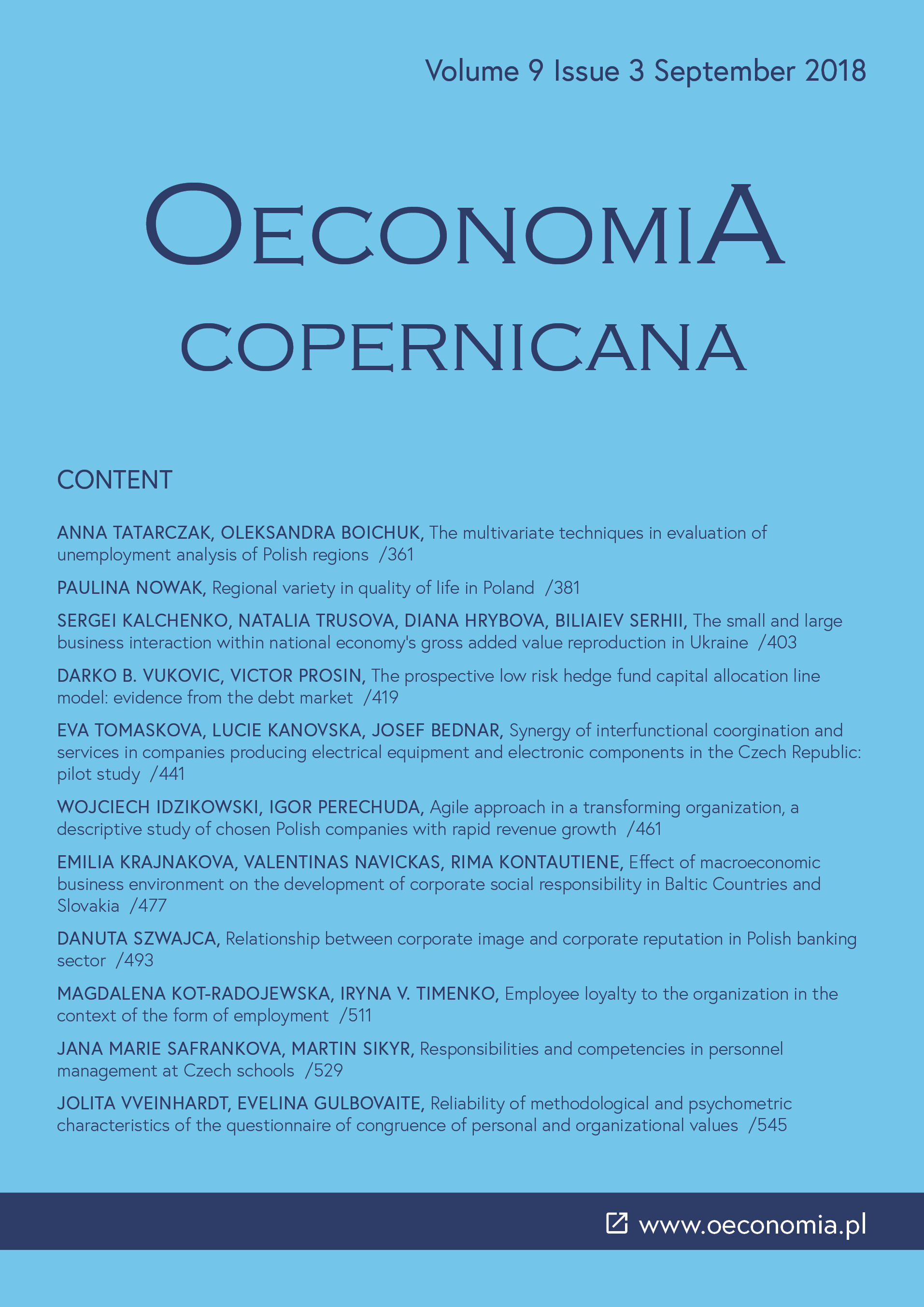The small and large business interaction within national economy?s gross added value reproduction in Ukraine
DOI:
https://doi.org/10.24136/oc.2018.020Keywords:
small businesses, gross value added, economic potential, the interaction of large and small businessesAbstract
Research background: The main background of this article is the thesis that sectors of small business and large business respond differently to shifts in macroeconomic conditions.
Purpose of the article: This article is devoted to empirical evidence whether there are signs of small business ability to compensate for negative trends, emerging in the sectors of large and medium-sized business in Ukraine.
Methods: The dynamics of gross value added was chosen as the main indicator of small business potential to create compensatory effect for reduction in employment, share of value added and GDP, observed in sector of large and medium-sized business. For factor analysis of actual gross added value dynamics, the authors have built a multiplicative term, which expresses the different characteristics of economic activity in small, large and medium-sized business impact on the gross added value dynamics. The authors have also evaluated the specific impact of these factors using the method of chained substitution.
Findings & Value added: The results obtained by factors analysis did not prove the thesis about small business capacity to compensate for the negative trends observed in the sector of large and medium business. The trend of economic activity in small business sector, trend of labor productivity, and trend in dynamics of added value share in small business output were causes of gross value added decreasing in the national economy during the period researched. These results can be interpreted as a sign that in case of unchanged quality indicators of economic activity in small business sector (in the first turn, the labor productivity and share of value added in output) this sector ability to compensate for negative trends in large business will be very doubtful.
Downloads
References
Abraham, K. G., & Katz, L. F. (1986). Cyclical unemployment: sectoral shifts or aggregate disturbances? Journal of Political Economy, 94(3).
DOI: https://doi.org/10.1086/261387
View in Google Scholar
Alchian, A. A, & Demsetz, H. (1972). Production, information costs, and economic organization. American Economic Review, 62(4).
View in Google Scholar
Amosha, O. I. (2014). Industry and industrial policy of Ukraine 2013: trends, chal-lenges, opportunities: sciences-analytic report. Donecz`k: Institute of Industrial Economics.
View in Google Scholar
Bakanov, M. Y, & Sheremet, A. D. (1999). The theory of economic analysis: a textbook. Moskva: Finance and Statistics.
View in Google Scholar
Balcerzak, A. P., & Pietrzak, M. B. (2017). Digital economy in Visegrad coutnries. Multiple-criteria decision analysis at regional level in the years 2012 and 2015. Journal of Competitiveness, 9(2). doi: 10.7441/joc.2017.02.01.
DOI: https://doi.org/10.7441/joc.2017.02.01
View in Google Scholar
Balcerzak, A. P., & Pietrzak, M. B. (2016). Quality of institutions for knowledge-based economy within new institutional economics framework. Multiple criteria decision analysis for European Countries in the years 2000–2013. Economics & Sociology, 9(4). doi: 10.14254/2071-789X.2016/9-4/4.
DOI: https://doi.org/10.14254/2071-789X.2016/9-4/4
View in Google Scholar
Baumol, W. J, Panzar, J. C., & Willig, R. D. (1982). Contestable markets and the theory of industry structure. San Diego: Harcourt Brace Jovanovich.
View in Google Scholar
Baumol, W. .J. (1982). Contestable markets: an uprising in the theory of industry structure. American Economic Review, 20(72).
View in Google Scholar
Cieślik, A. (2017). Determinants of MNE activity in Poland: the case of firms from EU-15. Entrepreneurial Business and Economics Review, 5(1). doi: 10.15678/EBER.2017.050109.
DOI: https://doi.org/10.15678/EBER.2017.050109
View in Google Scholar
Cieślik, A., & Wincenciak, L. (2018). Intra-industry trade in differentiated and homogenous commodities: Brander and Krugman models unified. Equilibrium. Quarterly Journal of Economics and Economic Policy, 13(1). Doi: 10.24136/eq.2018.002.
DOI: https://doi.org/10.24136/eq.2018.002
View in Google Scholar
Coase, R. H. (1937). The nature of the firm. Economica, New Series, 4(16).
DOI: https://doi.org/10.2307/2626891
View in Google Scholar
Foerster, A. T., Sarte, P. G., & Watson, M. W. (2011). Sectoral versus aggregate shocks: a structural factor analysis of industrial productio. Journal of Political Economy, 119(1). doi: 10.1086/659311.
DOI: https://doi.org/10.1086/659311
View in Google Scholar
Geyecz, V. M. (2010). New course of Ukrainian reforms in 2010-2015: national report. Kyiv: NVCz NBUV.
View in Google Scholar
Kudinova, A. V. (2015). Social reproduction: basic theories and models. Economy and Entrepreneurship, 33(1).
View in Google Scholar
Kvasnyuk, B. E. (2000). National savings and economic growth. Kyiv: MP Lesya.
View in Google Scholar
Leibenstein, H. (1966). Allocative efficiency vs "x-efficiency". American Economic Review, 56(3).
View in Google Scholar
Marshall, A. (2013). Principles of economics. Basingstoke: Palgrave Macmillan.
DOI: https://doi.org/10.1057/9781137375261
View in Google Scholar
Mason, E. (1939). Price and production policies of large-scale enterprise. American Economic Review, Supplement, 29.
View in Google Scholar
Pietrzak, M. B., Balcerzak, A. P., Gajdos, A., & Arendt, Ł (2017). Entrepreneurial environment at regional level: the case of Polish path towards sustainable socio-economic development. Entrepreneurship and Sustainability Issues, 5(2). 190-203, doi: 10.9770/jesi.2017.5.2(2).
DOI: https://doi.org/10.9770/jesi.2017.5.2(2)
View in Google Scholar
Schumpeter, J. A. (2012). The theory of economic development an inquiry into profits, capital, credit, interest, and the business cycle. New Brunswick, NJ: Transaction Publ.
View in Google Scholar
State Statistics Service of Ukraine (2016). Activity of subjects of large, medium, small and microbusiness: statistical collection. Kyiv: Publishing house "Con-sultant".
View in Google Scholar
Verba, D. V. (2007). The system of workplaces reproduction as a factor on the labor productivity dynamics for domestic enterprises. Economy of Ukraine: So-cial Aspects of an Innovative Model of Development, 1(1).
View in Google Scholar
Wierzbicka, W. (2018). Information infrastructure as a pillar of the knowledge-based economy — an analysis of regional differentiation in Poland. Equilibrium. Quarterly Journal of Economics and Economic Policy, 13(1) . doi: 10.24136/eq.2018.007.
DOI: https://doi.org/10.24136/eq.2018.007
View in Google Scholar
Zygmunt, J. (2018). Entrepreneurial activity drivers in the transition economies. Evidence from the Visegrad countries. Equilibrium. Quarterly Journal of Economics and Economic Policy, 13(1). doi: 10.24136/eq.2018.005.
DOI: https://doi.org/10.24136/eq.2018.005
View in Google Scholar






